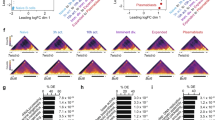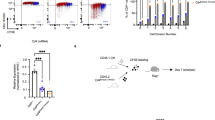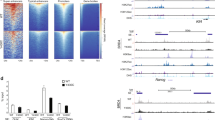Abstract
DNA double-strand breaks are generated by genotoxic agents and by cellular endonucleases as intermediates of several important physiological processes. The cellular response to genotoxic DNA breaks includes the activation of transcriptional programs known primarily to regulate cell-cycle checkpoints and cell survival1,2,3,4,5. DNA double-strand breaks are generated in all developing lymphocytes during the assembly of antigen receptor genes, a process that is essential for normal lymphocyte development. Here we show that in murine lymphocytes these physiological DNA breaks activate a broad transcriptional program. This program transcends the canonical DNA double-strand break response and includes many genes that regulate diverse cellular processes important for lymphocyte development. Moreover, the expression of several of these genes is regulated similarly in response to genotoxic DNA damage. Thus, physiological DNA double-strand breaks provide cues that can regulate cell-type-specific processes not directly involved in maintaining the integrity of the genome, and genotoxic DNA breaks could disrupt normal cellular functions by corrupting these processes.
This is a preview of subscription content, access via your institution
Access options
Subscribe to this journal
Receive 51 print issues and online access
$199.00 per year
only $3.90 per issue
Buy this article
- Purchase on Springer Link
- Instant access to full article PDF
Prices may be subject to local taxes which are calculated during checkout




Similar content being viewed by others
Accession codes
Primary accessions
Gene Expression Omnibus
Data deposits
The microarray gene expression data have been deposited in NCBI’s Gene Expression Omnibus (http://www.ncbi.nlm.nih.gov/geo/) under accession number GSE9024.
References
Shiloh, Y. ATM and related protein kinases: safeguarding genome integrity. Nature Rev. Cancer 3, 155–168 (2003)
Rouse, J. & Jackson, S. P. Interfaces between the detection, signaling, and repair of DNA damage. Science 297, 547–551 (2002)
Zhou, B. B. & Elledge, S. J. The DNA damage response: putting checkpoints in perspective. Nature 408, 433–439 (2000)
Innes, C. L. et al. ATM requirement in gene expression responses to ionizing radiation in human lymphoblasts and fibroblasts. Mol. Cancer Res. 4, 197–207 (2006)
Rashi-Elkeles, S. et al. Parallel induction of ATM-dependent pro- and antiapoptotic signals in response to ionizing radiation in murine lymphoid tissue. Oncogene 25, 1584–1592 (2006)
Tonegawa, S. Somatic generation of antibody diversity. Nature 302, 575–581 (1983)
Fugmann, S. D. et al. The RAG proteins and V(D)J recombination: complexes, ends, and transposition. Annu. Rev. Immunol. 18, 495–527 (2000)
Rooney, S., Chaudhuri, J. & Alt, F. W. The role of the non-homologous end-joining pathway in lymphocyte development. Immunol. Rev. 200, 115–131 (2004)
Meek, D. W. The p53 response to DNA damage. DNA Repair (Amst.) 3, 1049–1056 (2004)
Guidos, C. J. et al. V(D)J recombination activates a p53-dependent DNA damage checkpoint in scid lymphocyte precursors. Genes Dev. 10, 2038–2054 (1996)
Perkins, N. D. Integrating cell-signalling pathways with NF-κB and IKK function. Nature Rev. Mol. Cell Biol. 8, 49–62 (2007)
Huang, T. T., Wuerzberger-Davis, S. M., Wu, Z. H. & Miyamoto, S. Sequential modification of NEMO/IKKγ by SUMO-1 and ubiquitin mediates NF-κB activation by genotoxic stress. Cell 115, 565–576 (2003)
Gerondakis, S. et al. Unravelling the complexities of the NF-κB signalling pathway using mouse knockout and transgenic models. Oncogene 25, 6781–6799 (2006)
Bredemeyer, A. L. et al. ATM stabilizes DNA double-strand-break complexes during V(D)J recombination. Nature 442, 466–470 (2006)
Muljo, S. A. & Schlissel, M. S. A small molecule Abl kinase inhibitor induces differentiation of Abelson virus-transformed pre-B cell lines. Nature Immunol. 4, 31–37 (2003)
May, M. J. et al. Selective inhibition of NF-κB activation by a peptide that blocks the interaction of NEMO with the IκB kinase complex. Science 289, 1550–1554 (2000)
Wu, Z. H., Shi, Y., Tibbetts, R. S. & Miyamoto, S. Molecular linkage between the kinase ATM and NF-κB signaling in response to genotoxic stimuli. Science 311, 1141–1146 (2006)
Grawunder, U. et al. Expression of DNA-dependent protein kinase holoenzyme upon induction of lymphocyte differentiation and V(D)J recombination. Eur. J. Biochem. 241, 931–940 (1996)
Kashatus, D., Cogswell, P. & Baldwin, A. S. Expression of the Bcl-3 proto-oncogene suppresses p53 activation. Genes Dev. 20, 225–235 (2006)
Amaravadi, R. & Thompson, C. B. The survival kinases Akt and Pim as potential pharmacological targets. J. Clin. Invest. 115, 2618–2624 (2005)
Hayden, M. S. & Ghosh, S. Signaling to NF-κB. Genes Dev. 18, 2195–2224 (2004)
Rosen, S. D. Ligands for L-selectin: homing, inflammation, and beyond. Annu. Rev. Immunol. 22, 129–156 (2004)
Feng, C. et al. A potential role for CD69 in thymocyte emigration. Int. Immunol. 14, 535–544 (2002)
Matloubian, M. et al. Lymphocyte egress from thymus and peripheral lymphoid organs is dependent on S1P receptor 1. Nature 427, 355–360 (2004)
Shiow, L. R. et al. CD69 acts downstream of interferon-α/β to inhibit S1P1 and lymphocyte egress from lymphoid organs. Nature 440, 540–544 (2006)
Pearce, G. et al. Signaling protein SWAP-70 is required for efficient B cell homing to lymphoid organs. Nature Immunol. 7, 827–834 (2006)
Ladi, E., Yin, X., Chtanova, T. & Robey, E. A. Thymic microenvironments for T cell differentiation and selection. Nature Immunol. 7, 338–343 (2006)
Johnson, K. et al. Regulation of immunoglobulin light-chain recombination by the transcription factor IRF-4 and the attenuation of interleukin-7 signaling. Immunity 28, 335–345 (2008)
Tokoyoda, K. et al. Cellular niches controlling B lymphocyte behavior within bone marrow during development. Immunity 20, 707–718 (2004)
Nagasawa, T. Microenvironmental niches in the bone marrow required for B-cell development. Nature Rev. Immunol. 6, 107–116 (2006)
Rooney, S. et al. Leaky Scid phenotype associated with defective V(D)J coding end processing in Artemis-deficient mice. Mol. Cell 10, 1379–1390 (2002)
Gu, Y. et al. Growth retardation and leaky SCID phenotype of Ku70-deficient mice. Immunity 7, 653–665 (1997)
Mandik-Nayak, L., Racz, J., Sleckman, B. P. & Allen, P. M. Autoreactive marginal zone B cells are spontaneously activated but lymph node B cells require T cell help. J. Exp. Med. 203, 1985–1998 (2006)
Brockman, J. A. et al. Coupling of a signal response domain in IκBα to multiple pathways for NF-κB activation. Mol. Cell. Biol. 15, 2809–2818 (1995)
Ramsden, D. A. & Gellert, M. Formation and resolution of double-strand break intermediates in V(D)J rearrangement. Genes Dev. 9, 2409–2420 (1995)
Khor, B. et al. Proteasome activator PA200 is required for normal spermatogenesis. Mol. Cell. Biol. 26, 2999–3007 (2006)
Weaver, B. K., Bohn, E., Judd, B. A., Gil, M. P. & Schreiber, R. D. ABIN-3: a molecular basis for species divergence in interleukin-10-induced anti-inflammatory actions. Mol. Cell. Biol. 27, 4603–4616 (2007)
Weng, L. et al. Rosetta error model for gene expression analysis. Bioinformatics 22, 1111–1121 (2006)
Acknowledgements
We thank J. Bednarski, B. Van Honten and M. Diaz for critical review of the manuscript, F. W. Alt for providing us with the Artemis-/- mice and D. Ballard for providing us with the IκBα-ΔN construct. This research is supported by the National Institutes of Health (NIH, grant AI47829) and the Washington University Department of Pathology and Immunology (to B.P.S.); the Department of Pathology and Center for Childhood Cancer Research of the Children’s Hospital of Philadelphia, and the Abramson Family Cancer Research Institute (to C.H.B.); and the intramural research program of the NIH, National Institute of Environmental Health Sciences (to R.S.P.). B.P.S. is a recipient of a Research Scholar Award from the American Cancer Society. C.H.B. is a Pew Scholar in the Biomedical Sciences. A.L.B. is supported by a post-doctoral training grant from the NIH.
Author information
Authors and Affiliations
Corresponding author
Supplementary information
Supplementary Information
This file contains Supplementary Figures 1-18 with Legends and Supplementary Tables 1-5 (PDF 4294 kb)
Rights and permissions
About this article
Cite this article
Bredemeyer, A., Helmink, B., Innes, C. et al. DNA double-strand breaks activate a multi-functional genetic program in developing lymphocytes. Nature 456, 819–823 (2008). https://doi.org/10.1038/nature07392
Received:
Accepted:
Published:
Issue Date:
DOI: https://doi.org/10.1038/nature07392
This article is cited by
-
Noncoding RNA processing by DIS3 regulates chromosomal architecture and somatic hypermutation in B cells
Nature Genetics (2021)
-
A non-canonical, interferon-independent signaling activity of cGAMP triggers DNA damage response signaling
Nature Communications (2021)
-
At the intersection of DNA damage and immune responses
Nature Reviews Immunology (2019)
-
Tia1 dependent regulation of mRNA subcellular location and translation controls p53 expression in B cells
Nature Communications (2017)
-
Ataxia telangiectasia: a review
Orphanet Journal of Rare Diseases (2016)
Comments
By submitting a comment you agree to abide by our Terms and Community Guidelines. If you find something abusive or that does not comply with our terms or guidelines please flag it as inappropriate.



